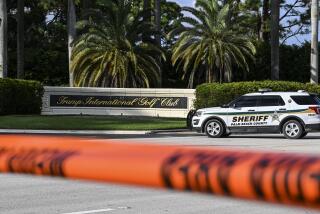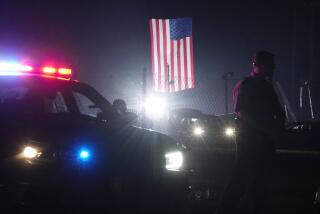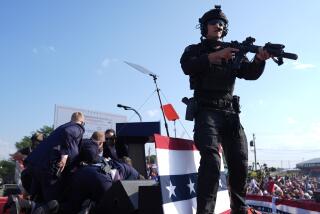Bush Flees Tear Gas, Gunshots in Panama : Diplomacy: U.S. agents lead a chaotic evacuation from plaza, where President was to have spoken, after authorities fire to curb protesters. He and wife are unhurt.
PANAMA CITY — Gunshots and tear gas fired by local authorities and maybe others drove President Bush from a stage in a downtown plaza here Thursday when he was just moments away from delivering a speech in praise of the revival of democracy in Panama.
Secret Service agents carrying automatic weapons led a chaotic evacuation from the plaza, whisking the President and his wife, Barbara, to a nearby American air base for safety.
Waiting for his speech, a joyous, flag-waving throng of about 3,000 Panamanians abruptly panicked at the sound of gunfire and dull explosions apparently caused by the launching of tear gas at protesters demonstrating on the fringes of the crowd.
The throng’s enthusiasm turned to pandemonium as a stinging, choking mist of tear gas wafted across the plaza.
As the crowd surged forward, Secret Service agents surrounded Bush, draped him in a bulletproof coat and hustled him and the First Lady rearward away from the stage, amid a stampede of guests and invited dignitaries. Everyone’s eyes streamed from the effects of the tear gas.
A second wave of heavily armed Secret Service agents pressed forward to meet the crowd, pointing their weapons and directing the crowd away from the President and his party. Others, brandishing submachine guns and pistols and some wearing gas masks, crouched near Bush’s limousine as the Plaza Porras was transformed into something resembling a war zone.
With weapons-toting agents perched on the running boards, Bush and a small party sped away to the air base that was the site of his next scheduled Panama City stop. Unhurt and only a little flustered, Bush described the incident as the result of a “tiny left-wing demonstration.”
The White House said it did not believe Bush was ever in immediate danger. But the scare was by far the most serious involving an American President since the attempted assassination of Ronald Reagan in 1981.
John Magaw, head of the Secret Service, said the decision to evacuate Bush to safety was made after shots were fired by local authorities and by unidentified others at the scene. Magaw said there was “no indication” that any of the American Secret Service agents had fired their weapons.
Witnesses saw Panamanian authorities firing tear-gas canisters toward demonstrators on the fringes of the crowd at the plaza, but it was not clear whether tear gas was used before or after the initial gunfire. White House spokesman Marlin Fitzwater said that shots fired by Panamanian authorities may have been merely warning shots.
The violent episode served as a sharp reminder of resentment and discontent boiling beneath the surface of some segments of Panamanian society 2 1/2 years after Bush ordered a U.S. invasion of this country to oust military dictator Manuel A. Noriega from power.
An American serviceman, identified by the Pentagon on Thursday as Army Cpl. Zak A. Hernandez, 22, of Guayanilla, Puerto Rico, was killed by gunfire in an ambush Wednesday as tensions mounted before the President’s controversial visit. A second soldier, identified as Sgt. Ronald T. Marshall, 24, of Fordyce, Ark., was seriously hurt in the ambush. In another incident, bullets were sprayed at a U.S. military base.
But Administration officials said no serious consideration had been given to canceling the President’s stopover here of a few hours en route to the Earth Summit in Rio de Janeiro, Brazil. The Panama stop had been envisioned as a hero’s welcome for Bush that might divert attention from his expected frosty reception at the Rio summit.
And despite the events that forced him to flee the scene of his scheduled speech to the Panama crowd, the White House was determined to portray his visit as one marking the triumph of peace and democracy here after the ouster of Noriega, who was jailed and later tried in the United States for drug trafficking and money laundering.
“It’s been a very good visit with the exception of the tear gas and the demonstrations,” Fitzwater said.
While Bush was not able to deliver the speech planned for the downtown plaza, he incorporated some of his intended remarks into an address to members of Panama’s American community at Albrook Air Base, where his limousine and another vehicle carrying senior White House advisers took refuge after the plaza episode.
Members of the Albrook crowd did not seem to have heard about what had happened downtown, and Bush made only passing reference to that scare. “I must say that the plaza where we came from, there’s a history there of protest and also vigil,” Bush said. “But today that plaza is the people’s park. And I wish every one of you could have seen the welcome we had before a handful of characters tried to disrupt it all.”
Bush told the crowd that he and Mrs. Bush will “never forget the warm welcome you gave us as we drove in from the airport and, indeed, as we drove to this base.”
And, in fact, until the first explosions sounded at the edge of the downtown crowd, Bush had unabashedly basked in a demonstrative public show of support for what the U.S. invasion of 1989 had brought about.
Playing to the hilt his reelection-campaign role as the “undisputed leader of the Free World,” Bush made a triumphant return to the scene of his Administration’s first military victory, driving past thousands of Panamanians who lined the city’s streets and left his limousine flecked with yellow chrysanthemums.
Despite reports of gunfire elsewhere in the city, Bush attended a luncheon hosted by Panamanian President Guillermo Endara and extolled the recovery led by Endara, who took his oath of office at a U.S. military base on the night of the invasion in December, 1989.
“For the tiny, tiny handful of people who are protesting,” Bush said in a luncheon toast in the ornate Salon de los Tamarindos at the presidential palace, “I say they ought to go up to San Francisco and see what a real protest is like.”
For his part, Endara praised Bush as a “friend of Panama.”
The enthusiastic throngs of Panamanians who had cheered Bush on his way into town from the airport gave way to more sullen gatherings as the President passed through poorer neighborhoods en route to the scheduled downtown speech. Some held signs protesting the U.S. invasion and its leveling of the Panama City district of El Chorillo.
There was no sign of discontent for the first few minutes after Bush arrived at Plaza Porras, where he was greeted by a cheering throng of dignitaries and other guests assembled by the Panamanian government. The crowd even sang “Happy Birthday” to mark Bush’s 68th birthday today.
But as Bush and Endara sat on the stage listening to the words of an introductory speaker, the first of a series of dull explosions could be heard on the fringe of the crowd, and tear gas rose into the air.
Bush at first looked unconcerned, but he and the First Lady appeared increasingly tense as the dull explosions continued and Secret Service agents took up positions at their sides. The agents could be seen clearing an escape path for Bush and beginning to draw their weapons.
Within moments, the effect of the tear gas could be seen on the panicky, damp faces of the members of the crowd and on Barbara Bush. A group of children there to perform for the event was hustled from the stage, and one Secret Service agent stood ready behind the President with a bulletproof raincoat.
Panamanian officials could be seen drawing their weapons and firing tear-gas canisters into the air.
Then amid shouts and screams, Panamanians began to surge forward and to break through wooden barriers that separated the audience from Bush and a buffer zone set aside for reporters.
In what proved to be a chaotic evacuation, reporters and television crews joined the dignitaries and guests in a rearward flight toward Bush’s motorcade, while the President and Mrs. Bush were escorted in protective pockets of agents.
As reporters ran to waiting vans, Secret Service agents could be seen loading live ammunition into their weapons and taking up positions behind a low retaining wall along the driveway where Bush’s limousine waited.
One agent was seen pointing a pistol directly at a Panamanian citizen’s chest and ordering him to get away. Reporters were ushered into vans that sped away, carrying them and some White House officials to safety at the nearby American Embassy.
But Bush and senior White House officials including Chief of Staff Samuel K. Skinner, National Security Adviser Brent Scowcroft and Press Secretary Fitzwater made their escape in a smaller “secure package” that included armed Secret Service agents clinging to a vehicle’s sides.
Panama officials said they believe the demonstration to which authorities responded with tear gas and gunshots was led by students from nearby University of Panama.
More to Read
Sign up for Essential California
The most important California stories and recommendations in your inbox every morning.
You may occasionally receive promotional content from the Los Angeles Times.










